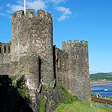MERLIN’S
HILL - CARMARTHEN
Working Farm B&B and Iron Age Hill Fort
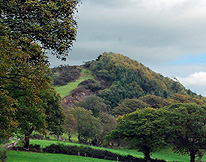 Merlin the Magician – wizard or druid mystic has appeared in legends
for a thousand years. He has made appearances in epic poems of romantic
medieval myths of King Arthur and his Knights of the Round Table, the
mystic engineer of Arthur’s birth to Uther Pendragon and Igraine,
a mentor wizard who lives forward and backward in time, half born of
a demon and half druid priest ultimately entrapped forever in a netherworld
by the enchantress half-sister of Arthur, Morgan Le Fey. Merlin’s
popular culture images range from a historical force instrumental in
the national legend of Britain, Disney's befuddled kindly mentor, to
a cable television show of a young wizard as clever nerd to Arthur’s
fair-haired frat boy. He has been transformed as inspiration for other
literary and pop culture characters, from Gandalf in Lord of the Rings,
Obi-Wan Kenobi in Star Wars, to even Dumbledore in Harry Potter. But
was he ever a real person? The answer to that is a myth wrapped in the
riddle.
Merlin the Magician – wizard or druid mystic has appeared in legends
for a thousand years. He has made appearances in epic poems of romantic
medieval myths of King Arthur and his Knights of the Round Table, the
mystic engineer of Arthur’s birth to Uther Pendragon and Igraine,
a mentor wizard who lives forward and backward in time, half born of
a demon and half druid priest ultimately entrapped forever in a netherworld
by the enchantress half-sister of Arthur, Morgan Le Fey. Merlin’s
popular culture images range from a historical force instrumental in
the national legend of Britain, Disney's befuddled kindly mentor, to
a cable television show of a young wizard as clever nerd to Arthur’s
fair-haired frat boy. He has been transformed as inspiration for other
literary and pop culture characters, from Gandalf in Lord of the Rings,
Obi-Wan Kenobi in Star Wars, to even Dumbledore in Harry Potter. But
was he ever a real person? The answer to that is a myth wrapped in the
riddle.
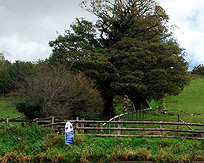 In south
Wales just 2 miles to the east of Carmarthen along the road toward
the Brecon
Beacons Park is a round promontory of green grass and
gnarled trees topped by some ancient stones called Merlin’s Hill
(Bryn Myrddin). What has come to us of the wizardly Merlin and King Arthur
is bound in the writings of two clerics of the middle ages. Geoffrey
of Monmouth was a Welsh speaking Benedictine monk teacher at Oxford’s
St. George's College, writing in the 12th Century of the mystical foundations
of the British Isles in his “History of the Kings of Britain” (Historia
Regum Britanniae) essentially creating the fanciful myth story of King
Arthur from early Breton historical figures. Gerald of Wales was another
cleric born from a powerful Norman family in Wales, born around 1146
in Pembrokeshire of mixed Norman and Welsh parentage, grandson of the
Gerald Fitzwalter the constable of Pembroke Castle under William Marshal
(see Pembroke
Castle). He had risen to Archdeacon of Brecon and tried
unsuccessfully to get himself named as Bishop of St David’s where
his uncle had held the post (see St Davids Bishops Palace). He served
as chaplain to Henry II, before falling into some disfavor. His literary
career began
with the telling of Henry II’s conquest of Ireland.
In south
Wales just 2 miles to the east of Carmarthen along the road toward
the Brecon
Beacons Park is a round promontory of green grass and
gnarled trees topped by some ancient stones called Merlin’s Hill
(Bryn Myrddin). What has come to us of the wizardly Merlin and King Arthur
is bound in the writings of two clerics of the middle ages. Geoffrey
of Monmouth was a Welsh speaking Benedictine monk teacher at Oxford’s
St. George's College, writing in the 12th Century of the mystical foundations
of the British Isles in his “History of the Kings of Britain” (Historia
Regum Britanniae) essentially creating the fanciful myth story of King
Arthur from early Breton historical figures. Gerald of Wales was another
cleric born from a powerful Norman family in Wales, born around 1146
in Pembrokeshire of mixed Norman and Welsh parentage, grandson of the
Gerald Fitzwalter the constable of Pembroke Castle under William Marshal
(see Pembroke
Castle). He had risen to Archdeacon of Brecon and tried
unsuccessfully to get himself named as Bishop of St David’s where
his uncle had held the post (see St Davids Bishops Palace). He served
as chaplain to Henry II, before falling into some disfavor. His literary
career began
with the telling of Henry II’s conquest of Ireland.
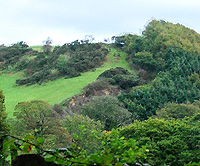 Gerald
wrote of his travels through Wales with the Archbishop Baldwin encountering
the
site of a prophecy from 400 years earlier of the downfall
of a Welsh King near the River Conwy (see Conwy
Castle). Gerald of Wales
told of two Merlins, one a Scottish troubadour turned mad poet wild man
of the woods - Myrddin Wyllt (Merlin the Wild) and
another, a young boy prophet, Myrddin Emrys (Merlin of
Emrys), who prophesied to King Vortigern the deafeat
of the Saxon's
white dragon by the Welsh red dragon,
who was "begotten by a demon
incubus,
born
at
Caermardin (Carmarthen) the city of Merlin" while the other Merlin
grew mad, "taking shelter in a wood, passed the remainder of his days
in
a savage state.” The young prophet who predicted
a king's victory establishing the Red Dragon as
the symbol of Wales and the mad wild man of the woods became joined in
the
legends
as told
by
Geoffrey
and later romanticized in the 15th Century at the height of the age of
chivalry by Thomas Mallory in his Le Morte d’Arthur, and in the
16th Century by Edmund Spenser in The Faerie Queen (see Lismore
Castle Gardens). Modern UFO theories even use the legends
of Merlin to suggest he had a magic wand using alien anti-gravity technology
to move the stones
of Stonehenge into place. This from Geoffrey telling of Merlin’s
moving the stones from a Giant’s Circle in Ireland to Stonehenge,
amazing the medieval knights by his working of ropes and levers to make
the stones appear to float, more advanced engineer than alien power.
Gerald
wrote of his travels through Wales with the Archbishop Baldwin encountering
the
site of a prophecy from 400 years earlier of the downfall
of a Welsh King near the River Conwy (see Conwy
Castle). Gerald of Wales
told of two Merlins, one a Scottish troubadour turned mad poet wild man
of the woods - Myrddin Wyllt (Merlin the Wild) and
another, a young boy prophet, Myrddin Emrys (Merlin of
Emrys), who prophesied to King Vortigern the deafeat
of the Saxon's
white dragon by the Welsh red dragon,
who was "begotten by a demon
incubus,
born
at
Caermardin (Carmarthen) the city of Merlin" while the other Merlin
grew mad, "taking shelter in a wood, passed the remainder of his days
in
a savage state.” The young prophet who predicted
a king's victory establishing the Red Dragon as
the symbol of Wales and the mad wild man of the woods became joined in
the
legends
as told
by
Geoffrey
and later romanticized in the 15th Century at the height of the age of
chivalry by Thomas Mallory in his Le Morte d’Arthur, and in the
16th Century by Edmund Spenser in The Faerie Queen (see Lismore
Castle Gardens). Modern UFO theories even use the legends
of Merlin to suggest he had a magic wand using alien anti-gravity technology
to move the stones
of Stonehenge into place. This from Geoffrey telling of Merlin’s
moving the stones from a Giant’s Circle in Ireland to Stonehenge,
amazing the medieval knights by his working of ropes and levers to make
the stones appear to float, more advanced engineer than alien power.
Merlin’s Hill Farm
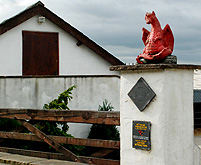 At the top of Merlin’s Hill from a steep hike are the remains
of one of a few large hill forts from the Iron Age in West Wales, which
once controlled large swaths of territories in the valleys and glens.
The Romans established a fortified town in in the Towy Valley on the
site of the current Carmarthen in 75 AD. Drawing from Gerald’s
writings that the town was the birthplace of Merlin, and that he lived
in the mountain forests, the legend grew that Merlin lived in a cave
somewhere at the hilltop fort and still remains entombed there by enchantment,
hence named Merlin’s Hill. The cave is long vanished along with
most of the fort, but visitors can explore what little remains of the
outline among the trees and shrubs on a hillside nature walk.
At the top of Merlin’s Hill from a steep hike are the remains
of one of a few large hill forts from the Iron Age in West Wales, which
once controlled large swaths of territories in the valleys and glens.
The Romans established a fortified town in in the Towy Valley on the
site of the current Carmarthen in 75 AD. Drawing from Gerald’s
writings that the town was the birthplace of Merlin, and that he lived
in the mountain forests, the legend grew that Merlin lived in a cave
somewhere at the hilltop fort and still remains entombed there by enchantment,
hence named Merlin’s Hill. The cave is long vanished along with
most of the fort, but visitors can explore what little remains of the
outline among the trees and shrubs on a hillside nature walk.
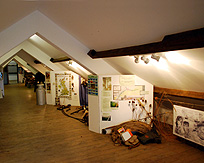 The legend of Merlin’s Hill is tended by the family of the Alltyfyrddin
Farm, on whose property the hill of Merlin’s mysterious fate lies.
A working dairy and sheep farm with bed and breakfast accommodations
and small museum dedicated to the history of the valley, sheep farming
and the wizard wild man. The Alltyfyrddin Bed & Breakfast on the
farm offers country style Bed and Breakfast lodging in an updated farmhouse
from the early 1700s with beamed ceilings and nook fireplace, featuring
five bedrooms of single, double, twin and family rooms, tastefully decorated,
all with en-suite facilities. The farm fresh breakfast comes from local
produce. The Merlin’s Hill Farm produces its own wool products
of scarfs, throws, and blankets spun locally from its Jacob Sheep available
for purchase and the Merlin’s Hill Centre is the starting place
for exploring the hill and natural trails through the hills views.
The legend of Merlin’s Hill is tended by the family of the Alltyfyrddin
Farm, on whose property the hill of Merlin’s mysterious fate lies.
A working dairy and sheep farm with bed and breakfast accommodations
and small museum dedicated to the history of the valley, sheep farming
and the wizard wild man. The Alltyfyrddin Bed & Breakfast on the
farm offers country style Bed and Breakfast lodging in an updated farmhouse
from the early 1700s with beamed ceilings and nook fireplace, featuring
five bedrooms of single, double, twin and family rooms, tastefully decorated,
all with en-suite facilities. The farm fresh breakfast comes from local
produce. The Merlin’s Hill Farm produces its own wool products
of scarfs, throws, and blankets spun locally from its Jacob Sheep available
for purchase and the Merlin’s Hill Centre is the starting place
for exploring the hill and natural trails through the hills views.
Carmarthenshire
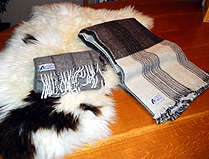 The Alltyfyrddin Farm
B&B makes for a base to explore Carmarthenshire’s
landscape from Carreg Cennen Castle and Brecon Beacons to the coast of
Laugharne, inspiration to the poet Dylan Thomas (see Dylan Thomas
Boathouse)
or nostalgic steam train rides on the Gwili Railway, just around the
corner (see Bronwydd Arms Station and Gwili Railway), or just stop by
for a hike up the hill.
The Alltyfyrddin Farm
B&B makes for a base to explore Carmarthenshire’s
landscape from Carreg Cennen Castle and Brecon Beacons to the coast of
Laugharne, inspiration to the poet Dylan Thomas (see Dylan Thomas
Boathouse)
or nostalgic steam train rides on the Gwili Railway, just around the
corner (see Bronwydd Arms Station and Gwili Railway), or just stop by
for a hike up the hill.
Visiting Merlin’s Hill Centre
The Merlin's Hill Centre is open daily except Christmas day from 10am to 7pm April to October: 10am to 5pm November to March. Admission is £3 for adults, £1.50 for Children and £2 for Seniors and Disabled (though access up the hill is limited) and a Family Ticket for £9. Parking is on the farm property so be prepared for close encounters with the curious and friendly sheep which trod the paths once possibly wandered by the ephemeral mystical Merlin. © Bargain Travel Europe
Compare hotel and travel deals in Carmarthen on TripAdvisor
Web Info
Merlins Hill Farm
Centre
These articles are copyrighted and the sole property of Bargain Travel Europe and WLPV, LLC. and may not be copied or reprinted without permission.
SEE ALSO:
DINEFWR CASTLE PARK AND NEWTON HOUSE
CARREG CENNEN CASTLE - LLANDEILO
CAREW
CASTLE & TIDAL MILL
CAERPHILLY
CASTLE
FAMILY HISTORY RESEARCH CENTER - SWANSEA

